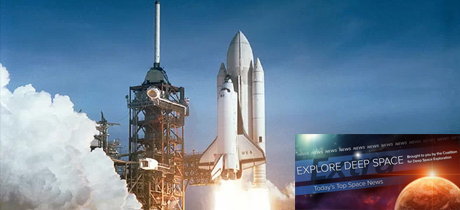In Today’s Deep Space Extra… NASA workshop reveals growing global interest in human lunar exploration. Lost tragically 15 years ago today, NASA’s shuttle Columbia and its seven astronauts remain an inspiration. Experts confirm the recent re-discovery of NASA’s long lost IMAGE mission satellite.
Human Space Exploration
Shooting for the moon–this time to stay
Scientific American (1/31): A recent gathering of experts for NASA’s Lunar Science for Landed Missions Workshop at the Ames Research Center in California featured a global enthusiasm for future human exploration of the moon, an enthusiasm that reaches from the U.S. to Europe, Russia, China, Japan and India. NASA’s proposed human lunar orbiting Deep Space Gateway and Europe’s proposed Moon Village could offer new opportunities for exploration, scientific insight into the early solar system and commercial enterprise.
Debris from fallen space shuttle Columbia has new mission 15 years after tragedy
Collectspace.com (2/1): Today marks the 15th anniversary of the space shuttle Columbia tragedy, which claimed the lives of seven astronauts as the winged spacecraft broke apart during re-entry over Texas. Debris from the loss, archived at NASA’s Kennedy Space Center, continues to serve as source of education and inspiration for young space workers.
Space Science
Here are some amazing pictures of the January 2018 lunar eclipse
Universe Today (1/31): Miss Wednesday’s early morning Super Moon lunar eclipse? Stunning photos linger.
Blast from the past: How Explorer 1, America’s first satellite, launched the space race and NASA
Los Angeles Times (1/31): Late Wednesday marked the 60th anniversary of the first U.S. satellite launch, Explorer 1. Fast tracked with expertise from what is now NASA’s Jet Propulsion Laboratory, the launch and mission were successes. Explorer 1 revealed the Earth’s Van Allen Belts and helped the U.S. catch up with the former Soviet Union in space after the launches of Sputnik 1 and 2.
NASA Goddard (1/30): Scientists at the Applied Physics Lab in Laurel, Maryland have confirmed the re-discovery of IMAGE, a NASA satellite launched into Earth orbit in March 2000 to study the Earth’s magnetosphere and thought lost and declared inactive in 2007. An amateur astronomer reported the possible rediscovery on Jan. 20. Efforts are underway to determine whether the spacecraft can resume science observations. Outdated software and data systems are an issue.
Other News
New companies needed to maintain small satellite market growth
Space News (1/31): A once surging market for small satellite launches may decline, according to an annual assessment from Atlanta-based SpaceWorks Engineering. Launches in 2017, more than 300, exceeded forecasts. Last year’s total marked a rebound from the two previous years, due largely to the activities of a single company, Planet, which contributed nearly half of the 2017 total. However, if other companies do not emerge, it appears the annual total is due for a decline.
60 years after Explorer 1, SpaceX delivers GovSat-1 to orbit
Florida Today (1/31): The launch of a SpaceX Falcon 9 rocket on Wednesday from Cape Canaveral Air Force Station, Florida, corresponded with the 60th anniversary of the first U.S. satellite launch, Explorer 1. The 4:35 p.m., EST, liftoff was followed 32 minutes later by the deployment of a joint venture commercial SES/Luxembourg government communications satellite on a course to geosynchronous orbit.
Soyuz-2-1a rocket launched a pair of Kanopus-V satellites, nine secondary payloads
Russian Space Web (2/1): A Russian Soyuz-2-1a rocket placed two Earth observing satellites and nine small U.S. and German satellite payloads in orbit Thursday, following liftoff from the Vostochny Cosmodrome. The mission marked a return to flight for the launch vehicle, following a November 28 mission failure.

